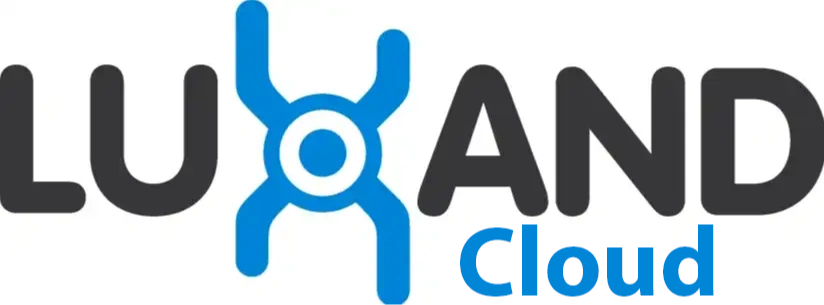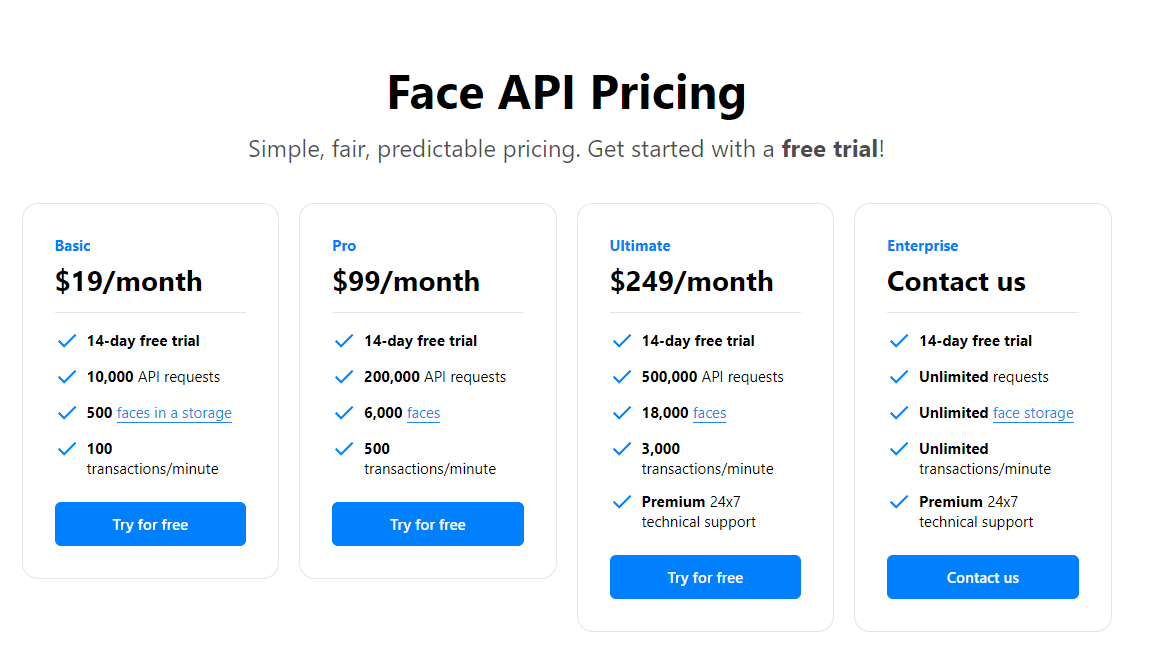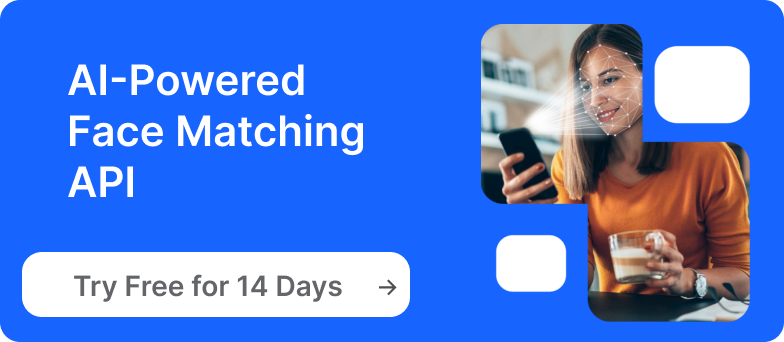
Top Face Matching APIs in 2024
Facial recognition technology has rapidly advanced, becoming an integral part of many industries, from security to retail. As we move through 2024, the demand for accurate and efficient face matching APIs is higher than ever, driven by the need for enhanced security, personalized customer experiences, and streamlined identity verification processes. This blog post explores the top face matching APIs available in 2024, examining their features, pricing, and performance to help you choose the best solution for your specific needs. Whether you're a developer, a business leader, or a tech enthusiast, this guide will provide valuable insights into the leading tools in facial recognition technology today.
Criteria for Selecting Face Matching APIs

When evaluating face matching APIs, it's crucial to consider several factors to ensure the chosen solution aligns with your specific needs and objectives. First and foremost, accuracy and performance are critical. The API must reliably identify and match faces under various conditions, including different lighting, angles, and expressions. High accuracy reduces false positives and negatives, which is essential for applications like security, identity verification, or any context where precision is paramount.
Equally important is security and privacy. As face matching often involves sensitive personal data, the API must offer robust security measures to protect this information. This includes data encryption, compliance with regulations like GDPR, and the assurance that user data is handled responsibly. The provider's commitment to privacy and data protection is a key consideration, especially for businesses operating in highly regulated industries.
The integration and ease of use of the API are also vital. The API should be developer-friendly, with comprehensive documentation, support for multiple programming languages, and easy integration into existing systems. A well-documented API reduces development time and allows for faster deployment, which is especially beneficial for businesses looking to quickly implement face matching capabilities.
Another factor to consider is cost and licensing. Different APIs come with varying pricing models, ranging from pay-per-use to subscription-based plans. Understanding the cost implications, including any additional fees for higher usage, is essential to ensure the solution remains within budget. Additionally, it's important to review the licensing terms to ensure they align with your intended use case, whether it’s for commercial, educational, or research purposes.
Finally, scalability is a key consideration for businesses anticipating growth. The API should be able to handle an increasing volume of requests without a decline in performance. Scalability ensures that as your user base or application needs expand, the API can continue to deliver reliable and efficient face-matching services.
By carefully considering these criteria, you can select a face-matching API that not only meets your current needs but also supports your long-term goals.
Luxand.cloud Face Matching API
Luxand.cloud Face Matching API is a specialized tool designed for precise and efficient facial recognition. Known for its advanced technology, Luxand.cloud offers a range of features that cater to various industries, making it a strong contender in the facial recognition market.
Key Features
Luxand.cloud Face Matching API is equipped with a suite of features that enable accurate face detection and recognition. It supports real-time facial recognition, allowing users to compare faces quickly and reliably across images and videos. One standout feature is its ability to recognize faces even when they are partially obstructed or when the subject's appearance has changed, such as with different hairstyles or facial hair. Luxand.cloud also offers emotion detection and age estimation, providing additional insights that can be valuable in customer service or marketing applications. Moreover, the API is highly customizable, allowing developers to fine-tune its settings to meet specific needs, such as adjusting the sensitivity of face matching.
Use Cases
Luxand.cloud’s Face Matching API is versatile, making it suitable for a variety of applications. In the security sector, it can be used for surveillance and access control, where reliable identification is critical. For retail and e-commerce, the API can enhance customer experiences by enabling personalized services, such as targeted marketing or customer identification at checkouts. In healthcare, Luxand.cloud can be utilized for patient identification and monitoring, ensuring that the right care is provided to the right person. Additionally, the API finds applications in social media and entertainment, where it can power features like automatic photo tagging or creating interactive content based on user faces.
Pricing
Luxand.cloud offers a flexible pricing model that caters to different needs, ranging from small-scale projects to large enterprises. Pricing is typically based on the number of API calls, with options to scale up as usage increases.

Pros and Cons
Luxand.cloud Face Matching API offers several advantages that make it a compelling choice for developers and businesses. High accuracy and robust performance are among its most significant strengths, ensuring reliable face matching even under challenging conditions. The API’s customizability allows developers to tailor its performance to specific needs, enhancing its versatility. Another benefit is its ease of integration; Luxand.cloud is designed to be developer-friendly, with clear documentation and support for multiple programming languages, making the implementation process smooth and straightforward. Additionally, the scalability of Luxand.cloud ensures that as your business grows, the API can handle increased demand without compromising on performance.
In summary, Luxand.cloud Face Matching API is a powerful tool with a range of features that make it suitable for various applications. Its high accuracy, ease of integration, and flexible pricing model make it an attractive option for businesses looking to implement reliable facial recognition technology.
Speaking about cons, the cost can become significant for high-volume users, especially as usage scales up. Additionally, while the API offers a range of features, it may require technical expertise to fully integrate and optimize within more complex systems.

Amazon Rekognition
Key Features
Amazon Rekognition stands out with its robust face detection and matching capabilities. It can accurately identify and compare faces in real-time, even in complex scenarios involving variations in lighting, angles, and facial expressions. The API also supports facial analysis, providing insights such as gender, age range, emotions, and facial attributes like beards or glasses. Additionally, Rekognition offers face indexing, which allows you to create a searchable repository of faces, making it easier to match new faces against existing records. Integration with other AWS services further enhances its functionality, allowing for seamless scalability and security.
Pricing
Amazon Rekognition operates on a pay-as-you-go model, making it accessible to businesses of all sizes. The cost is determined by the number of images or videos processed, and there are different pricing tiers depending on the volume and specific features used, such as face detection or face comparison. This flexible pricing structure allows companies to scale their usage based on demand, paying only for what they need without a significant upfront investment.
Pros and Cons
One of the major advantages of Amazon Rekognition is its accuracy and reliability in face matching, thanks to AWS's advanced machine learning algorithms. The API's ease of integration with other AWS services also simplifies deployment, particularly for organizations already using the AWS ecosystem. Additionally, its scalability is a strong point, as it can handle large volumes of data without compromising performance.
However, there are some drawbacks to consider. The cost can become significant for high-volume users, especially for real-time video processing. Some users have also raised concerns about privacy and ethical implications, particularly in sensitive applications like surveillance. Finally, while Rekognition is powerful, it may require technical expertise to implement effectively, which could be a barrier for smaller businesses or teams without dedicated IT resources.
Microsoft Azure Face API
Key Features
Microsoft Azure Face API is packed with features that support accurate and efficient face detection and recognition. One of its primary capabilities is face verification, which compares two faces to determine if they belong to the same person. The API also supports facial identification from a database of known individuals, allowing for quick matching in applications like security systems. Additionally, it provides detailed facial attribute analysis, including the detection of age, gender, emotion, and other facial features. The API is designed to work seamlessly with other Azure services, facilitating easy integration into broader cloud-based solutions.
Pricing
The pricing model for Microsoft Azure Face API is consumption-based, meaning users pay according to the number of transactions or API calls they make. This model offers flexibility, as organizations can scale their usage up or down based on their specific needs. Microsoft Azure also provides different pricing tiers that cater to various usage levels, which can be particularly beneficial for businesses with fluctuating demands. Additionally, there are free-tier options for developers looking to experiment with the API before committing to a paid plan.
Pros and Cons
The advantages of using Microsoft Azure Face API include its high accuracy and reliability, backed by Microsoft’s extensive experience in AI and cloud computing. The API’s integration with the broader Azure ecosystem is another significant benefit, enabling seamless use alongside other Microsoft services. Scalability is also a strong point, as the API can handle large-scale operations without performance degradation.
On the other hand, there are some drawbacks to consider. The cost can accumulate quickly for businesses with high-volume needs, especially if real-time processing is required. Additionally, some users may find the API’s dependence on the Azure platform limiting if they prefer or are already committed to other cloud services. Privacy concerns are another consideration, particularly in sensitive applications, where the handling and storage of biometric data need to be managed carefully to comply with regulations.

Google Cloud Vision API
Key Features
Google Cloud Vision API is equipped with several key features that enhance its functionality. The API excels at face detection and comparison, allowing users to match faces across different images with high accuracy. It also supports facial landmark detection, identifying specific points on the face such as eyes, nose, and mouth, which can be useful for more detailed analysis or custom applications. Additionally, the API provides emotion detection and the ability to recognize facial attributes like age range and the presence of facial hair. The API’s integration with Google Cloud’s suite of tools ensures seamless deployment and scalability, especially for businesses already using Google’s cloud services.
Pricing
Google Cloud Vision API follows a pay-as-you-go pricing model, where users are charged based on the number of API calls made. This model offers flexibility, allowing businesses to scale their usage according to their needs without incurring unnecessary costs. Google Cloud also offers various pricing tiers, which can help businesses optimize their expenditure based on their specific usage patterns. Additionally, for those just starting out, there are free tier options available, enabling developers to explore the API's capabilities without immediate financial commitment.
Pros and Cons
The advantages of using Google Cloud Vision include its high accuracy and reliability, supported by Google’s advanced machine learning algorithms and extensive experience in AI. The API’s integration with Google Cloud services is another significant benefit, allowing for easy scaling and efficient management of cloud resources. The API’s developer-friendly environment with extensive documentation and support also contributes to a smoother integration process.
However, there are some drawbacks to consider. The cost of the API can become substantial for businesses with high-volume needs, particularly if they require real-time processing or handle large datasets. Additionally, some users might find the API’s reliance on Google Cloud services restrictive, especially if they are already invested in another cloud provider. There are also privacy concerns to consider, particularly in industries where the handling of biometric data is highly regulated, requiring careful management to ensure compliance.
Face++
Key Features
The Face++ API is equipped with a range of features that cater to various facial recognition needs. One of its primary capabilities is accurate face detection, which allows the API to identify and analyze faces in images with high precision. The API also supports face comparison, enabling users to match two faces and determine whether they belong to the same person. Additionally, Face++ offers facial landmark detection, which identifies key points on the face such as eyes, nose, and mouth, providing detailed insights that can be useful in more complex applications. The API also includes age estimation and emotion detection, allowing for a broader range of use cases where understanding more about the face is beneficial. Moreover, the API is highly adaptable, with the ability to integrate seamlessly into various systems and workflows.
Pricing
Face++ operates on a tiered pricing model, which offers flexibility based on the volume of API calls and the specific features used. This approach allows businesses of different sizes to find a plan that suits their needs, whether they are handling a small number of requests or managing large-scale operations. The pricing is generally consumption-based, meaning that costs will increase with higher usage, but it also allows for scalability as business demands grow. Face++ provides different packages that can be tailored to specific requirements, ensuring that companies only pay for what they need.
Pros and Cons
The advantages of the Face++ include its high accuracy and reliability, which are crucial for applications where precise facial recognition is needed. The API’s versatility is another key benefit, as it can be easily integrated into various platforms and used in a wide range of industries, from security and finance to retail and social media. The detailed facial analysis features, such as age estimation and emotion detection, add extra value by providing more context around the identified faces.
On the downside, there are some drawbacks to consider. The cost of the API can escalate quickly, particularly for businesses with high-volume requirements or those using advanced features. Additionally, the API’s reliance on cloud infrastructure may pose concerns about data security and privacy, especially in industries where sensitive information is involved. Another potential limitation is the need for technical expertise to fully implement and optimize the API, which might be a barrier for smaller organizations or those without a dedicated IT team.

Clarifai
TheAPI by Clarifai is equipped with several key features that enhance its functionality and flexibility. Central to its offering is accurate face detection and recognition, allowing users to identify and match faces across different images and videos with high precision. The API also includes facial attribute analysis, which can detect specific characteristics such as age, gender, and emotions, adding depth to its face recognition capabilities. Additionally, Clarifai supports custom model training, enabling businesses to fine-tune the API to meet their specific needs by training it on their own datasets.
Pricing
Clarifai offers a flexible pricing structure that is designed to accommodate different levels of usage, from small projects to large-scale operations. The pricing model is generally based on the number of API calls, with different tiers available to suit varying business demands. For those just starting out, Clarifai provides a free tier that includes a limited number of API calls, making it accessible for developers to explore its capabilities. As usage increases, businesses can move to higher tiers, with costs scaling according to the volume of requests and the complexity of the features used.
Pros and Cons
The advantages of Clarifai's API include its ease of integration and user-friendly interface, which makes it accessible even to those with limited technical expertise. The API's customizability is another significant benefit, allowing businesses to train the model on their own data to improve accuracy and relevance in specific applications. Additionally, Clarifai is known for its strong support and documentation, which helps developers quickly implement and optimize the API.
However, there are some drawbacks to consider. The cost can become a factor for businesses with high usage requirements, especially if they require real-time processing or extensive custom model training. While the API is flexible, the initial setup and fine-tuning might require more time and expertise, which could be a barrier for smaller businesses or those without dedicated technical teams. Additionally, as with any cloud-based service, there are potential privacy concerns related to the handling and storage of biometric data, particularly in industries with stringent regulatory requirements.
Conclusion
Each API, from Luxand.cloud to Clarifai, brings its unique strengths—whether it's high accuracy, ease of integration, or scalability. However, choosing the right API depends on your specific requirements, such as the need for customizability, budget constraints, or concerns about data privacy. By carefully evaluating the key features, pricing, and pros and cons of each option, you can select the face matching API that best aligns with your goals, ensuring you harness the full potential of this advanced technology in your applications.
